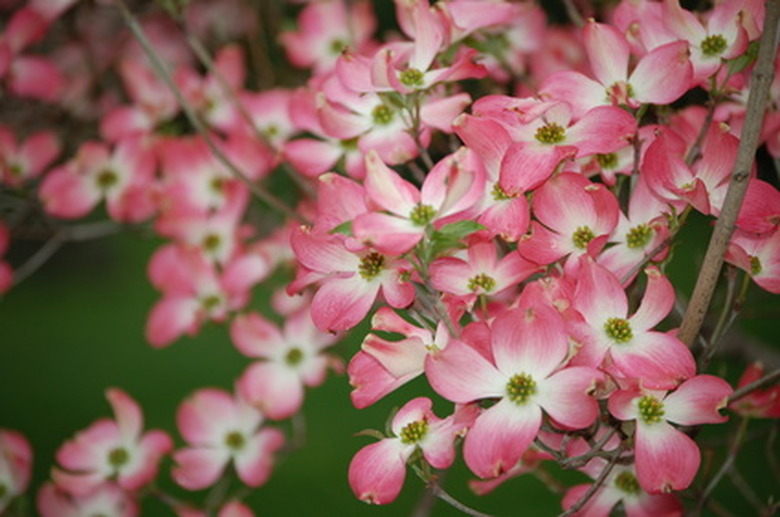Pink Dogwood Varieties
Blooming at about the same time as redbud trees in the eastern American woodlands, pink flowering dogwoods (Cornus florida forma rubra) produce pink to rose to rose-red bracts around their true tiny greenish-yellow flowers. The Missouri Botanical Garden mentions that pink-flowering varieties of this tree are slightly less cold hardy, particularly the flower and bract buds, so grow it best in USDA Hardiness Zones 5 through 9.
Cherokee Series
Touted as being more vigorous and disease-resistant than other flowering dogwoods, varieties in the Cherokee Series include a couple of pink-flowering selections. 'Cherokee Brave' forms white bracts that are mottled and streaked with deep rose coloration, and 'Cherokee Chief' develops bracts that are dark rose-red, arguably not pink but looking more blood red at times. 'Cherokee Sunset' bracts are deep rose pink with a hint of violet, lighter than those of 'Cherokee Chief.'
American Beauty
Pleasant rosy-red bracts occur on 'American Beauty,' and newly emerging leaves have a reddish tint to them. It may sometimes be labeled or called 'American Beauty Red' or 'Red Beauty.'
- Blooming at about the same time as redbud trees in the eastern American woodlands, pink flowering dogwoods (Cornus florida forma rubra) produce pink to rose to rose-red bracts around their true tiny greenish-yellow flowers.
- Pleasant rosy-red bracts occur on 'American Beauty,' and newly emerging leaves have a reddish tint to them.
Spring Song
Some people describe the bracts of 'Spring Song' to be deep rosy pink, while others may say it's rose-red. These colors blush atop white bracts, so the overall effect is light pink.
Gulf Coast Pink
One of the best pink-flowering varieties for long, hot summer regions, 'Gulf Coast Pink' bears pink bracts and ranks among the best choices if you live in Florida north of Orlando and desire a pink flowering dogwood tree.
Cornus Kousa 'Satomi'
While not a species of flowering dogwood, the kousa dogwood variety 'Satomi' produces rosy pink bracts in late spring to early summer. This species, Cornus kousa, tolerates sunny locations better than other types and is not affected by anthracnose as flowering dogwoods are.
Varieties Of Flowering Dogwood
Flowering dogwood trees usually reach 20 to 30 feet and are often just as wide, making a dramatic specimen for the garden or patio. This deciduous tree is characterized by horizontal branches along most of the trunk, with a rounded or more upright crown. Oval leaves grow opposite, and the bark of mature trees is broken into squares, giving it a checkered appearance. More than half of the two dozen or so species of flowering dogwood bloom in white. Heavy and early bloomer "Cherokee Princess" grows to a height of 20 to 25 feet and sports 3- to 4-inch flowers that put on a spectacular show in April or May. Fall leaves turn red to purple and retain a silvery hue. The checkered bark and gray stems provide contrasting winter interest. " This specimen is often trained as a multi-trunked tree, as higher branches grow upright and lower branches extend horizontally.
- Some people describe the bracts of 'Spring Song' to be deep rosy pink, while others may say it's rose-red.
- Flowering dogwood trees usually reach 20 to 30 feet and are often just as wide, making a dramatic specimen for the garden or patio.
References
- Missouri Botanical Garden: Cornus Florida f. rubra
- Journal of Arboriculture; Cultivar Checklists of the Large-Bracted Dogwoods;" Frank S. Santamour, Jr. and Alice Jacot McArdle; Jan. 1985
- "A-Z Encyclopedia of Garden Plants"; Christopher Brickell and H. Marc Cathey, eds.; 2004
- Thuja Gardens: Flowering Dogwoods: Cherokee Princess
- Southern Living: Flowering Dogwood
- Direct Gardening: Dogwood, Pink
- USDA: Plant Guide: Flowering Dogwood
- e-ReferenceDesk: New Jersey State Trees
- Super-Sod Trees: Cherokee Princess Dogwood
- Arbor Day Foundation: Autumn Gold Dogwood
- Missouri Botanical Garden: Cornus 'Rutgan' Stellar Pink
- Arbor Day Foundation: Dogwood, Pink
- Backyard Gardener.com: Cornus florida
